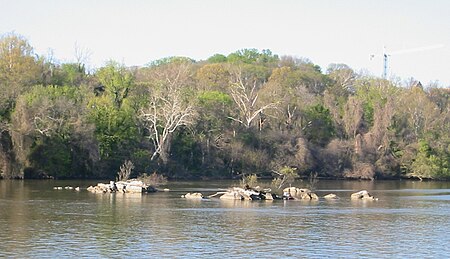Three Sisters Bridge

The Three Sisters Bridge was a planned bridge over the Potomac River in Washington, D.C., with piers on the Three Sisters islets. Envisioned in the 1950s and formally proposed in the 1960s, it was cancelled amid protests in the 1970s. A bridge over the Potomac in the same location was first proposed in 1789, and bridges have been planned every few decades since then. In the 1950s, the creation of the George Washington Memorial Parkway and the extension of the parkway onto the north side of the Potomac River from Chain Bridge to Carderock, Maryland, led to calls to turn Canal Road NW into a highway and to build a bridge over the Three Sisters to link the two sections of parkway. The rationale for a Three Sisters Bridge changed over the years. At one time, the bridge was to be part of the "Inner Loop" system of spoke-and-hub freeways planned for the District of Columbia. At another, it was intended to bring then-unbuilt Interstate 66 into the city. The bridge proposal proved highly contentious and is a notable example of a "highway revolt". Local residents of the Georgetown neighborhood and the citywide Committee of 100 on the Federal City opposed the bridge. Opponents of superhighways in the District of Columbia also opposed the bridge, as part of their opposition generally to the Inner Loop. Several protests involved civil disobedience, and some were violent. The Three Sisters Bridge spawned numerous lawsuits, one of which reached the Supreme Court of the United States. Representative William Natcher, a strong proponent of the bridge and chair of a key congressional subcommittee, withheld funding from the Washington Metro for six years in order to pressure the city into constructing the bridge. A legislative revolt in the United States House of Representatives in late 1971 released these funds. With Natcher unable to coerce the city, the bridge proposal effectively died. It was removed from federal planning documents in 1977.
Excerpt from the Wikipedia article Three Sisters Bridge (License: CC BY-SA 3.0, Authors, Images).Three Sisters Bridge
Capital Crescent Trail, Washington
Geographical coordinates (GPS) Address Nearby Places Show on map
Geographical coordinates (GPS)
| Latitude | Longitude |
|---|---|
| N 38.9039 ° | E -77.0806 ° |
Address
Capital Crescent Trail
Capital Crescent Trail
20057 Washington
District of Columbia, United States
Open on Google Maps






